President's Message
The General Assembly of Virginia created a Commission to commemorate the 75th anniversary of the US entry into WWII and the 100th anniversary of US entry into WWI. "The Dawn of Infamy Veteran's Tribute" was held December 8, 2016 at the University of Richmond's Robins Center. More than 80 WWII veterans were in attendance, 100 active-duty military escorts, and hundreds of family and friends gathered to honor the men and women of the greatest generation for their service."
Did you know that although what became U of R was annexted into the City of Richmond, some portions of the campus remain in Henrico County?
On April 5, 2017, the 100th anniversary of America's entry into WWI, a ceremony was held at Virginia's official state memorial to World War I, the Carillon Tower at William Byrd Park in Richmond, was dedicated in 1932 to memory of the 3,700 Virginians who lost their lives in WWI. The gold star on the entry plaza pays tribute to the mothers who lost their sons. The last veteran of WWI, Frank Buckles, of West Virginia, died February 27, 2011, at the amazing age of 110.
Communities throughout the Commonwealth are encouraged to commemorate these imporant events in American history. The County of Henrico, as part of the 4th of July celebration at Meadow Farm, will honor veterans of WWII.
The Henrico County Historical Society will sponsor a very exciting event on September 2 at the Sandston Memorial Recreation Center.
Did you know the Recreation Center was the former site of a USO Center?
We plan to recreate what it was like in a USO Center in the 1940's. Many periods of history we can only read about, but the 1940's is an era of which we can actually relate. Many of our fathers, husbands, brothers, and friends served their country then. The citizens on the home front did their part to support the war effort in many ways. There were scrap metal drives to gather materials to build ships and other necessary equipment, one of which was a contest in which a community would be chosen to have a ship named for it. That is how the naming of USS Henrico came about. Our friends with the USS Henrico Reunion Association recently shared an article about the origin of "Kilroy was here." Did you know the USS Henrico (APA-45) participated in the landing at Omaha Beach? There is a monument there with Henrico APA-45 engraved on it.
The purpose of the USO Centers was to create a home away from home for the troops. Some of the entertainment groups traveled overseas and performed before thousands of troops in large venues or for just a few troops in remote areas.
Did you know comedian Bob Hope did his first USO show before an audience of servicement as he broadcast his radio program from March Field in Riverside, California in 1941?
We hope you will attend the event on Saturday, September 2nd at the Sandston Memorial Recreation Center and travel back in time with us to the 1940s. The event will be free as it would have been at a USO Center. There will be refreshments, music, and other entertainment. You may even want to participate in a dance contest. Dressing in period attire is optional. There will be scanners to make copies of any materials, so we encourage you to bring photos to share your family's experiences to honor those who took part in history. For information please call (804) 839-2407.
In addition to a plaque with the names of those in Sandston who made the ultimate sacrifice in WWII, there is a framed handwork on teh wall at the Sandston Memorial Recreation Center that says, "Land of the free because of the brave."
Sarah Pace,
President
>Back to Top<
June Quarterly Meeting
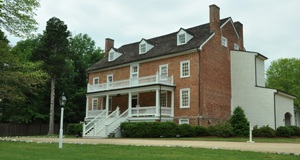
Dr. Louis Manarin will make a presentation called "Henricoans I Have Known". Come hear his personal account of interesting county characters.
The meeting starts 2:30 p.m. on Sunday, June 4, 2017. It will be at the Walkerton Tavern, located at 2892 Mountain Road in Glen Allen, VA 23060.
See you there!
>Back to Top<
HCHS Election Time
It's time to elect officers for the HCHS. The following slate has been offered in nomination and will be voted on at the June meeting. Other nominations from the membership will be taken at that time.
- President: Sarah Pace
- Vice President: Valerie Bell
- Secretary: Diane Brownie
- Treasurer: Debbie Shuck
>Back to Top<
HCHS Renewal: Is There an Asterisk on Your Mailing Label?
If so, it's time to renew your HCHS membership.
Dues are as follows:
- Individual: $15.00
- Family: $20.00
- Student or Child: $5.00
- Supporting: $25.00
- Corporate: $100.00
- Benefactor: $300.00
- Lifetime: $500.00
Memberships make great gifts for grads and retirees.
Make checks payable to Henrico County Historical Society.
Mail checks to:
Henrico County Historical Society
P.O. Box 90775
Henrico, VA 23273-0075
Or go to http://henricohistoricalsociety.org/membership.payment.html and use Paypal.
>Back to Top<
On Display: USS Henrico
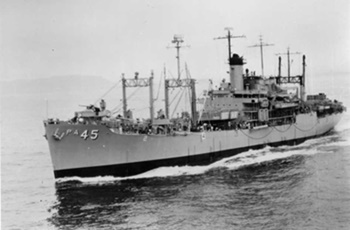
As we approach the 75th anniversary of our involvement in World War II, artifacts from the USS Henrico donated to the HCHS will go on public display at the Parham Road Government Complex. Originally built to serve the Ingalls Shipbuilding Corporation of Pascagoula, Mississippi, in 1942/1943, the ship sailed under the name SS Sea Darter until it was converted to an attack transport and commissioned the USS Henrico on November 26, 1943. Under the command of Navy Commander John H. Willis, the USS Henrico reported for duty in the U.S. Atlantic Fleet with Transport Division 11 on 3 December 1943. By the time the USS Henrico was decommissioned on 14 February 1968, she had well served her country for 25 years.
>Back to Top<
2017 HPAC Awards of Merit
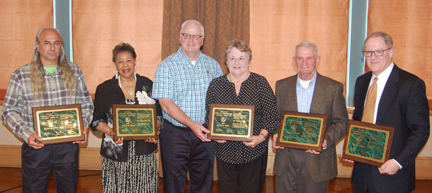
On Thursday, April 27, 2017, the Historic Preservation Advisory Committee held its annual Awards of Merit Ceremony at the Cultural Arts Center at Glen Allen. The committee recognized five contributions to preserving and promoting history in Henrico County.
Chief Terry Price accepted the award for the Wolf Creek Cherokee Tribe who were recognized for their museum and tribal center that preserves the heritage of the Wolf Creek Cherokee Tribe.
Ida Annette Minor Ward was presented with an Award of Merit for preserving "Recipes, Cooking Notions, Health, and Home Solutions" in her 600-page Southern cookbook, Switchin in Da Kitchin with Mama 'Nem, which was inspired by her mother, Ida B. Minor.
Brother and sister Tim Liles and Susan Nunnaly represented the Liles family, who were recognized for the family's work in securing the preservation of the Crew House, a nineteenth century landmark adjacent to Malvern Hill Battlefield.
When the Short Pump Civic Association disbanded, the organization presented a donation of $50,000 to the Henrico County Division of Recreation and Parks to actively increase public awareness of the rich educational history of the Short Pump area. Don Fitzgerald represented the group and accepted the award.
The Civil War Trust worked with the Liles family and bought the aforementioned Crew House, recorded an easement on the property and donated the property to the County of Henrico. Tom Gilmore accepted the award for the Trust.
>Back to Top<
APHA Commemorates Frayser Family
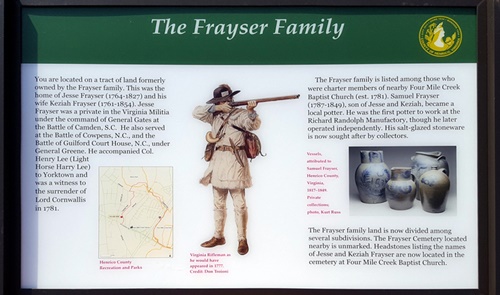
The Association for the Preservation of Henrico Antiquities has sponsored the placement of a historical marker that tells the story of the Frayser family, a prominent Varina family whose history goes back to colonial times. The text of the marker is as follows:
This was the home of Jesse Frayser (1764-1827) and his wife Keziah Frayser (1761-1854). Jesse Frayser was a private in the Virginia Militia under the command of General Gates at the Battle of Camden, S.C. He also served at the Battle of Cownpens, N.C., and the Battle of Guilford Court House, N.C., under General Greene. He accompanied Col. Henry Lee (Light Horse Harry Lee) to Yorktown and was a witness to the surrender of Lord Cornwallis in 1781.
The Frayser family is listed among those who were charter members of nearby Four Mile Creek Baptist Church (est. 1781). Samual Frayser (1787-1849), son of Jesse and Keziah became a local potter. He was the first potter to work at the Richard Randolph Manufactory, though he later operated independently. His salt-glazed stoneware is now sought after by collectors.
The Frayser family land is now divided among several subdivisions. The Frayser Cemetery located nearby is unmarked. Headstones listing the names of Jesse and Keziah Frayser are now located in the cemetery at Four Mile Creek Baptist Church.
The marker is in Varina on the Capital Trail on Route 5 west of Doran Road, on the right when traveling west.
>Back to Top<
Henrico Grapes Get Second Pressing
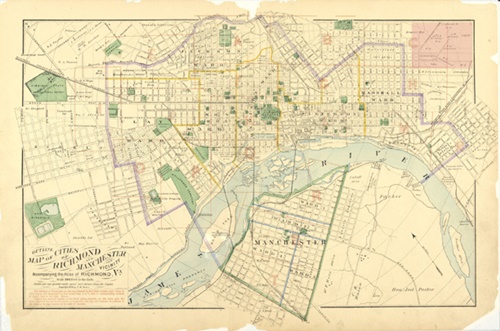
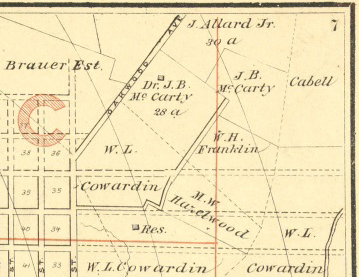
Henrico Vineyard. The area highlighted and enlarged (left) in F.W. Beers' 1876 "Outline Map of Cities of Richmond and Manchester" (above) shows the location of Dr. James Ball McCarty's 28-acre property.
We must confess to being under the influence of the grape for the past three months because of our research and article about Henrico's Dr. Daniel Norbert Norton and his development of Norton's Virginia Seedling, also known as the Norton grape. His propagation of this grape in the early 1820s resulted in an important addition to the American wine industry and, it seems, was only a part of Henrico County's nineteenth century viticulture, which involved a number of individuals and vineyards now gone from the landscape.
One of those men was John J. Werth, whose Glenwerth Vineyard was located near the Mechanicsville Turnpike. Werth was an avid viticulturist, traveling at one time to California to see the vineyards and to write about them. The California Vine Disease, an 1802 publication of the U.S. Department of Agriculture cites Werth's earlier writing by stating that the California "vines were as productive in 1851 as at present as is shown by the writings of John J. Werth, who mentions grapes in southern California vineyards in bunches of 2 to 4 pounds, and adds that they were credibly reported to reach 8 pounds."
Werth also shared his expertise in grape growing in the 1870 edition of The Grape Culturist (Volume II), and in so doing, also demonstrated somewhat of a poetic flair for metaphor and simile. In the article "Grafting The Vine," he offered four axioms he said he had "derived from analogy, observation and long practice in the art of grafting the grape vine." While the rules are interesting, analogies he makes are more unique. The second of his four points demands that in grafting vines, "infirm members, even of the desired family, should be scrupulously avoided" - a common sense admonition. But he then supports his argument with a long analogy. He suggests that one should no more hope to get a strong vine from those infirm members than "we should rely upon healthy and robust children from an infirm mother, even though the father was free from all taint...no well informed father commits his infant to the nourishment of a wet nurse who is notoriously a victim of scrofula in any of its various forms. Then, reasoning by a plain analogy, we should not commit a healthy scion to the nourishment of an infirm stock." He was apparently proud of his literary abilities since his metaphor was quite a bit longer than his advice.
But he hadn't exhausted his need to analogize. In defending his advice that the "process should be accomplished when the sap is not fluid," he produces a long simile. He writes: "As a wound in the animal will not granulate, the precedent condition to healing so long as bleeding is progressing, nor until coagulation of the blood occurs, so the wound in the lactated vegetable stock will not granulate and untie with the excoriated scion, while the exposed faces of the wounds are washed by the flowing sap."
His somewhat florid advice on grafting was dated June 7, 1870, and it was to be the last thing that Werth wrote. Many pages later in the same edition, the journal printed, "Again, it becomes our painful duty to announce to our readers the death of one of the veteran grape growers of the country, Col. John J. Werth." The magazine contacted his son, also John Werth, who indicated in a letter that his father had first turned his attention to grape cultivation about 1825, which happens to be right around the time Norton was propagating his grape. Ironically, the note on his death indicates that "On the 11th of March, while he was on a visit to a friend's grapery, near Richmond, Va., he ruptured an artery, and on the next morning at 4:30 he breathed his last." His son also sent along the death notice from a local newspaper, whose editor added after the obituary, "He has passed from earth, but his memory will remain green, and his example and teaching will animate many to 'go and do likewise.'"
An advertisement in the Daily Dispatch of November 3, 1870, announces an auction held by Thomas W. Keesee in which "Household furniture, pianos, grapevines, books &c." would be sold. Perhaps, this was the dispersal of Werth's estate because after the listing of much of the furniture, the ad went on to say that "5,500 GRAPEVINES from the Glenworth [sic] vineyard of Ives, Concord Ionas" would be offered. However, the son, it seems carred on the wine-making operation as is witnessed by an advertisement in the Daily Dispatch of June 21, 1871 (see illustration). It offers tours of Glenwerth with explanations by Mr. Werth of its operations.
When John J. Werth made his last journey to visit "a friend's grapery," he could have been headed for a number of vineyards, for there were several other vintners in the county. One was Dr. James Ball McCarty, who was a champion of Virginia grapes and who was cited in the Third Annual Report of the Commissioner of Agriculture of Virginia. The 1879 publication includes a section about the Norton Seedling, and also seems to refer to it as the "Concord." Whether or not the term applies to the Norton grape, the report notes that McCarty was impressed with it. And the authors of the report also recognized McCarty's ability (although they seem to have had a hard time spelling his name properly). The report states, "Dr. McCarthy [sic], of Henrico county, a successful grape-grower and wine-maker, expresses the opinion that he can make from it champagne of excellent quality.
While no articles or advertisements of the time indicate McCarty produced champagne, ads abound for his advertisements like that of the Daily Dispatch of July 17, 1873 for "AMERCAN WINES-HENRICO WINES, manufactured by Doctor James B. McCarty at his vineyard near Richmond, Virginia." He sold casks for 40 to 45 gallons for $1.25 per gallon, cases of 12 bottles for $5.00. He also offered what the ad named as "RED HENRICO," whose 10- to 45-gallon casks were sold at $1.00 per gallon and 12-bottle cases at $3.50. Just a few days earlier (July 5) the same newspaper had praised Dr. McCarty in a brief article under the heading "HENRICO WINES." Noting that he had been a successful cultivator of grapes for several years, it went on to say that he was offering several thousand gallons "pure and excellent wine" that was, according to "good judges...equal to the best American wines." And then came the call for residents to buy local products. It said, "If those who are engaged in this new industry receive the encouragement from the public which their efforts and products deserve, the culture of the grape in Virginia will soon develop into a large and flourishing branch of trade."
Locally, it seems, Dr. McCarty and his vineyard were well known, as an ad in the October 17, 1879, Daily Dispatch shows. In all caps, it used his land and operation as a reference point for potential customers. Advertising a brick dwelling for sale or for rent, the ad indicated that was located "ON OAKWOOD AVENUE OPPOSITE TO DR. McCARTY'S VINEYARD." Apparently, the public knew Dr. McCarty and his vineyard and would probably have been pleased to live nearby - why else mention it so prominently in the ad?
Dr. McCarty clearly took his wine-making seriously and viewed the practice as his vocation because in the census of 1880, where we find James B. McCarty in the Fairfield District identified as a "Vintinor"-spelling seems to be an ongoing issue with accounts of the good doctor. Reference to the thousands of gallons of McCarty wine also seem accurate, since the 1880 Industry Census for Henrico County indicates that his wine production for the year was valued at $1,800.
Directly beneath McCarty in the same 1880 Industry Census is listed another Henrico vintner, George K. Gilmer. His operation was apparently somewhat smaller than Dr. McCarty's, for the product of his vineyard was valued at $80 for that year. And the Agricultural Census for that same year gives us insight into some aspects of winemaking. Gilmer's 13-acre vineyard produced 60,000 pounds of grapes, and from those grapes he produced 750 gallons of wine. So it seems that it took about 80 pounds of grapes to produce a gallon of wine that would sell for just under a dollar.
Both McCarty and Gilmer needed to augment the proceeds gained from sales of wine since the Industry Census indicated that they had invested $2,000 and $1,000 respectively in their operations and had realized values of $1,800 and $800 respectively. They apparently did so through the sale of grape vines they had cultivated. On September 24, 1868, G. K. Gilmer advertised in the Daily Dispatch the sale of "ONE HUNDRED THOUSAND CHOICE GRAPE VINES FOR SALE AT THE MARIO HILL VINEYARDS, NEAR RICHMOND." He had no reservations aout praising his vines when he said they were the "largest and best-selected stock of GRAPE VINES ever produced in the South." And he offered a wide selection, including "Concords, Hartford Prolifics, Ive's Seedlings, Norton's Virginias, Cynthianas, Clintons, Delawares, Herbemonts, Ionas, &c., &c."
While the sale of vines may have kept Gilmer afloat, it seems that Dr. McCarty might not have been so successful because throughout October of 1880, ads in the Daily Dispatch announced the auction of his property. The October 23 edition offered Dr. J. B. McCarty's 28 acres, 17 of which were in grapes with 20,000 vines. It called it an "EXTRA AND HIGHLY-IMPROVED VINEYARD, which yields equal to any in the State, and where some of the celebrated grape-wines are made." It went on to claim, "The present owner has spent thousands of dollars in money and thirteen years in labor in time, thereby insuring a perfect success in making this the most valuable vineyard in the State." But the conditions of the sale suggest that those thousands of dollars and years of time had not brought in quite enough money. It seems that in 1874, two deeds had been taken out, and now the property had to be sold "at the request of the beneficiary, default having been made in the payment of money secured by said deeds."
If Dr. McCarty's efforts finally failed, it was not because his product had gone unnoticed or unappreciated, even beyond the city and county. On April 26, 1873, the Daily State Journal of Alexandria printed an account headed "Henrico Wines-Dr. McCarty." It was from what the paper called its Traveling Correspondent, who noted, "As a good deal of interest is manifested on the subject of native wines and wine making in Virginia, I wish to present some testimoney in favor of the excellent wines made by Dr. McCarty, of your city [Richmond]." The correspondent said that he and another judge tasted his wines, "and we all congratulated Dr. Mccarty on his success in producing such superb wines." But it seems that the reviewer had in addition to simply promoting the wine a bit of a prohibitionist goal, concluding the piece by adding, "and may they become more prevalent, and drive bad whiskey, and other villainous drinks, out of community."
Dr. McCarty was part of a small local group of men interested in winemaking, and they pooled their efforts to try and promote Virginia wines. According to the Daily Dispatch of December 17, 1877, "The area in cultivated grapes in Virginia has been growing from year to year until it has reached a point making an organization to utilize the results now possible. To get in shape a company," a group met at the office of the Planter and Farmer, formed committees to investigate various aspects of Virginia winemaking, planning to meet again on January 15, 1878. The members included the familiar names of Dr. McCarty and Dr. Gilmer. Another Henricoan also participated, O.A. Crenshaw. According to the 1879 Annual Report of the Commissioner of Agriculture of Virginia, his vineyard a mile from Richmond grew one acre of Concords and one acre of Norton's Seedlings. At the follow-up meeting in January, the Daily Dispatch of January 16 identified the group as The Virginia Wine-Growers Association. Little of note came of the meeting besides Crenshaw's "scheme for the formation of a join stock company for the manufacture of wine. And the only resolution passed was to request of the State Legislature to vote to repeal the Moffet-Register tax upon domestic wines. In 1877, the General Assembly had passed an act requiring licenses for the sale of liquor. Commissioners of revenue recorded amounts of liquor sold and reported them to the auditor of public accounts. The Moffett Register was a mechanical device for tallying sales of ardent spirits, malt liquor and wine, was adopted as the official register of liquor sold until 1880.
It seems that The Virginia Wine-Growers Association did not have a great effect on the wine-making industry in Virginia beyond its possible influence over the Moffet Register, since it was only used until 1880. But today's successful Virginia vintners should stand and toast the efforts of their Henrico forerunners.
Joey Boehling
Moffett Register: Early liquor dealer and saloon in the state was to be equipped with a Moffet Register to record sales of liquor, allowing state tax collectors to know taxes due.
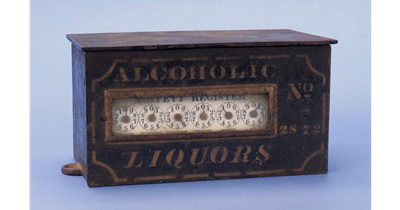
Promoting Henrico Winemaking
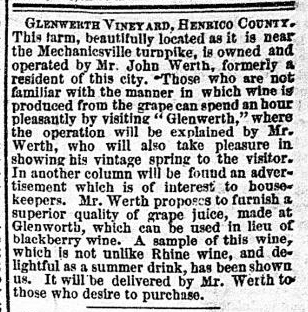
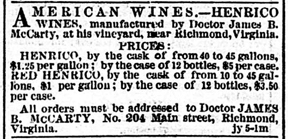
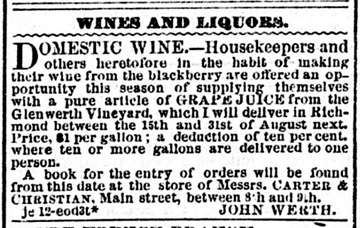
>Back to Top<
Now You Know: Dr. Rinehart's Tool Will Keep 'em From Going "Hog Wild"

Nobody was able to identify the last issue's iron "What Do You Know?" item. It was the Dr. Rinehart Handy Hog Holder. Patented November 24, 1931, it allowed pig farmers to literally lead their livestock around by the nose. The open end was slipped over the snout, and the pig could then be led to its destination. Smaller creatures required a smaller opening, hence the two different ends. We apologize for not depicting the side that had the name of the tool embossed on it, but that seemed too small a challenge for our readers to solve.
Unfortunately for the pig, its destination was quite likely its final destination. Fortunately for the owner, it was also destined to feed the family. Virginia's Mary Randolph offered a number of recipes for pork in The Virginia Housewife (1828).
Below are two of her recipes: one for sausages that seems fairly ordinary, and one that might call for a cook with quite broad tastes.
To Make Sausages
Take the tender pieces of fresh pork, chop them exceedingly fine-chop some of the leaf fat*, and put them together in the proportion of three pounds of pork to one fat, season it very high with pepper and salt, add a small quantity of dried sage rubbed to a powder, have the skins nicely prepared, fill them and hang them in a dry place. Sausages are excellent made into cakes and fried, but will not keep so well in skins.
* Leaf fat was layered fat found around the kidneys and loin in pigs.
Shote's Head
Take out the brains, and boil the head till quite tender, cut the heart and liver from the harslet, and boil the feet with the head; cut all the meat from the head in small pieces, mince the tongue and chop the brains small, take some of the water the head was boiled in, season it with onion, parsley and thyme, all chopped fine, add any kind of catsup - thicken it with butter and brown flour, stew the whole in it fifteen minutes, and put it in the dish; have the heart roasted to put in the middle; lay the broiled liver around, and garnish it with a green pickle.
Grinding It Out
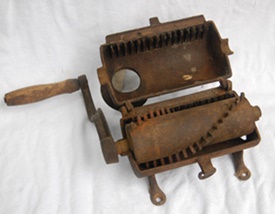
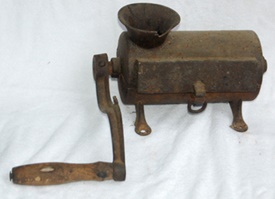
While Mary Randolph called for finely chopping the pork for sausages, late nineteenth century sausage makers had a crank-handled sausage grinder to ease their workload. Meat was loaded into the funnel at the top. Turning the crank turned the studded drum which forced the meat through the blades lining the inside of the cylinder. Ground pork then was forced out through the hole at the bottom on the opposite end.
Packing It In
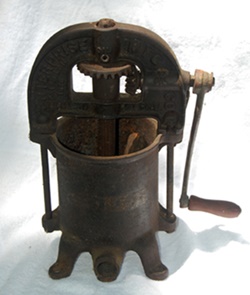
Once mixed, the sausage could be loaded into the barrel of this Enterprise sausage stuffer (patented 1886). The crank turned a gear that turned the central screw. It moved down the barrel, causing a plate attached to its bottom to force the sausage out of the opening and into the saugsage casing that had been affixed to the snout.
>Back to Top<
What Do You Know?
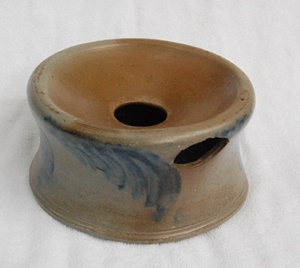
This stoneware item is 8.5" in diameter and 4.25" tall.
Do you know what it is?
Email your answers to jboehling@verizon.net.
>Back to Top<
News 2017: Second Quarter
First Quarter | Third Quarter | Fourth Quarter
Home | Henrico | Maps | Genealogy | Preservation | Membership | Shopping | HCHS
|











